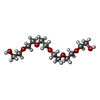+Search query
-Structure paper
| Title | Structural basis of assembly chaperone- mediated snRNP formation. |
|---|---|
| Journal, issue, pages | Mol Cell, Vol. 49, Issue 4, Page 692-703, Year 2013 |
| Publish date | Feb 21, 2013 |
 Authors Authors | Clemens Grimm / Ashwin Chari / Jann-Patrick Pelz / Jochen Kuper / Caroline Kisker / Kay Diederichs / Holger Stark / Hermann Schindelin / Utz Fischer /  |
| PubMed Abstract | Small nuclear ribonucleoproteins (snRNPs) represent key constituents of major and minor spliceosomes. snRNPs contain a common core, composed of seven Sm proteins bound to snRNA, which forms in a step- ...Small nuclear ribonucleoproteins (snRNPs) represent key constituents of major and minor spliceosomes. snRNPs contain a common core, composed of seven Sm proteins bound to snRNA, which forms in a step-wise and factor-mediated reaction. The assembly chaperone pICln initially mediates the formation of an otherwise unstable pentameric Sm protein unit. This so-called 6S complex docks subsequently onto the SMN complex, which removes pICln and enables the transfer of pre-assembled Sm proteins onto snRNA. X-ray crystallography and electron microscopy was used to investigate the structural basis of snRNP assembly. The 6S complex structure identifies pICln as an Sm protein mimic, which enables the topological organization of the Sm pentamer in a closed ring. A second structure of 6S bound to the SMN complex components SMN and Gemin2 uncovers a plausible mechanism of pICln elimination and Sm protein activation for snRNA binding. Our studies reveal how assembly factors facilitate formation of RNA-protein complexes in vivo. |
 External links External links |  Mol Cell / Mol Cell /  PubMed:23333303 PubMed:23333303 |
| Methods | EM (single particle) / X-ray diffraction |
| Resolution | 1.898 - 20.0 Å |
| Structure data |  EMDB-2102:  PDB-4f7u:  PDB-4v98: |
| Chemicals |  ChemComp-P6G:  ChemComp-HOH:  ChemComp-SO4: |
| Source |
|
 Keywords Keywords | SPLICING / Assembly Machine / Complex / Assembly Machinery |
 Movie
Movie Controller
Controller Structure viewers
Structure viewers About Yorodumi Papers
About Yorodumi Papers



 homo sapiens (human)
homo sapiens (human)

